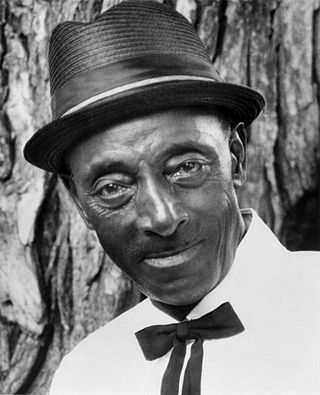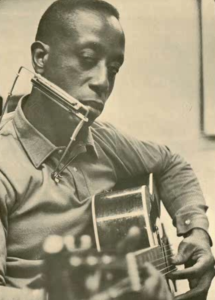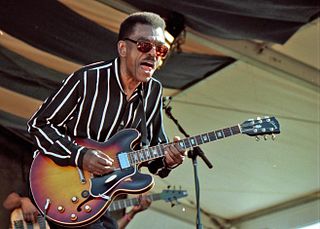
Delta blues is one of the earliest-known styles of blues. It originated in the Mississippi Delta and is regarded as a regional variant of country blues. Guitar and harmonica are its dominant instruments; slide guitar is a hallmark of the style. Vocal styles in Delta blues range from introspective and soulful to passionate and fiery.
Piedmont blues refers primarily to a guitar style, which is characterized by a fingerpicking approach in which a regular, alternating thumb bass string rhythmic pattern supports a syncopated melody using the treble strings generally picked with the fore-finger, occasionally others. The result is comparable in sound to ragtime or stride piano styles. Blues researcher Peter B. Lowry coined the term, giving co-credit to fellow folklorist Bruce Bastin. The Piedmont style is differentiated from other styles, particularly the Mississippi Delta blues, by its ragtime-based rhythms.

Fred McDowell, known by his stage name Mississippi Fred McDowell, was an American singer, songwriter and guitarist.

The Chattahoochee River forms the southern half of the Alabama and Georgia border, as well as a portion of the Florida and Georgia border. It is a tributary of the Apalachicola River, a relatively short river formed by the confluence of the Chattahoochee and Flint rivers and emptying from Florida into Apalachicola Bay in the Gulf of Mexico. The Chattahoochee River is about 430 miles (690 km) long. The Chattahoochee, Flint, and Apalachicola rivers together make up the Apalachicola–Chattahoochee–Flint River Basin. The Chattahoochee makes up the largest part of the ACF's drainage basin.

Samuel John "Lightnin" Hopkins was an American country blues singer, songwriter, guitarist and occasional pianist from Centerville, Texas. In 2010, Rolling Stone magazine ranked him No. 71 on its list of the 100 greatest guitarists of all time.

Georgia's musical history is diverse and substantial; the state's musicians include Southern rap groups such as Outkast and Goodie Mob, as well as a wide variety of rock, pop, blues, and country artists such as the late Ray Charles, Otis Redding, James Brown, and The Allman Brothers Band. The music of Athens, Georgia is especially well known for a kind of quirky college rock that has included such well-known bands as R.E.M., The B-52's, and Pylon.

R. L. Burnside was an American blues singer, songwriter and guitarist. He played music for much of his life but received little recognition before the early 1990s. In the latter half of that decade, Burnside recorded and toured with Jon Spencer, garnering crossover appeal and introducing his music to a new fan base in the punk and garage rock scenes.

Booker T. Washington "Bukka" White was an American Delta blues guitarist and singer.

Walter E. "Furry" Lewis was an American country blues guitarist and songwriter from Memphis, Tennessee. He was one of the earliest of the blues musicians active in the 1920s to be brought out of retirement and given new opportunities to record during the folk blues revival of the 1960s.
The bearcat, also known as the binturong, is a viverrine mammal from Southeast Asia.

Marion Brown was an American jazz alto saxophonist, composer, writer, visual artist, and ethnomusicologist. He was a member of the avant-garde jazz scene in New York City during the 1960s, playing alongside musicians such as John Coltrane, Archie Shepp, and John Tchicai. He performed on Coltrane's landmark 1965 album Ascension. AllMusic reviewer Scott Yanow described him as "one of the brightest and most lyrical voices of the 1960s avant-garde."

Richard K. "Dick" Spottswood is an American musicologist and author from Maryland, United States who has catalogued and been responsible for the reissue of many thousands of recordings of vernacular music in the United States.

Isaiah Ross, known as Doctor Ross, was an American blues musician who usually performed as a one-man band, simultaneously singing and playing guitar, harmonica, and drums. Ross's primal style has been compared to John Lee Hooker, Blind Boy Fuller and Sonny Boy Williamson I.

"Mississippi" Joe Callicott was an American Delta blues singer and guitarist.

Sylvester Johnson was an American blues and soul singer, musician, songwriter and record producer. His most successful records included "Different Strokes" (1967), "Is It Because I'm Black" (1969) and "Take Me to the River" (1975).

Johnny "Man" Young was an American blues singer, mandolin player and guitarist, significant as one of the first of the new generation of electric blues artists to record in Chicago after the Second World War. He was one of the few mandolin players active in blues music in the postwar era. His nickname, Man, came from his playing the mandolin.
Johnny Woods was an American blues singer and harmonica player in the north Mississippi hill country blues style.

Houston Stackhouse was an American Delta blues guitarist and singer. He is best known for his association with Robert Nighthawk. He was not especially noted as a guitarist or singer, but Nighthawk showed gratitude to Stackhouse, his guitar teacher, by backing him on a number of recordings in the late 1960s. Apart from a brief tour in Europe, Stackhouse confined his performing to the area around the Mississippi Delta.
Moses "Whispering" Smith was an American blues harmonicist and singer. He recorded tracks including "A Thousand Miles from Nowhere" and "Texas Flood" and worked with Lightnin' Slim and with Silas Hogan. He was inducted into the Louisiana Blues Hall of Fame.
Wade Walton was an American blues musician and local civil rights leader from Mississippi. He was also a renowned barber, who counted many famous musicians amongst his friends, colleagues, and customers.














